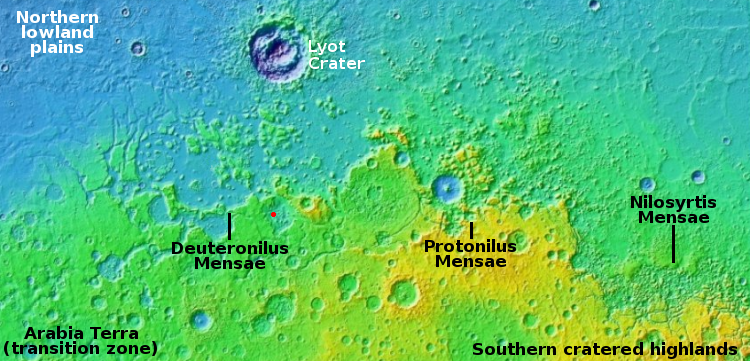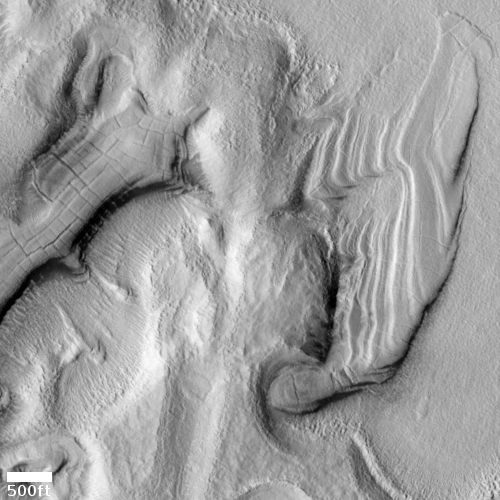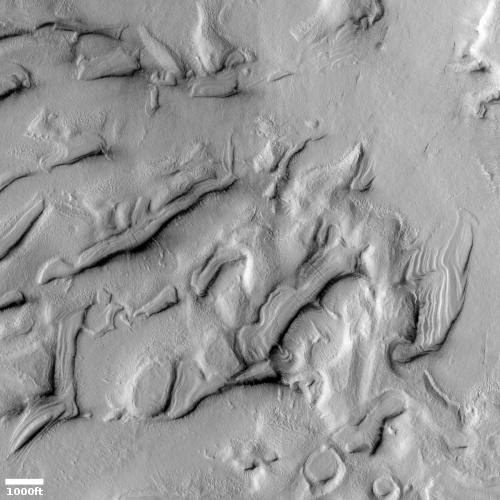Mars: Glaciers on top of glaciers on top of glaciers

Mars’ glacier country.
Cool image time! The photo to the right, rotated, cropped, and reduced to post here, was taken on December 12, 2021 by the high resolution camera on Mars Reconnaissance Orbiter (MRO). It shows a small patch of layered glacial features flowing in all directions. The overview map above marks its location by the red dot, at 40 degrees north latitude in the region dubbed Deuteronilus Mensae, on the western end of the 2,000 long strip from 30 to 60 degrees north latitude that I dub Mars’s glacier country because practically every image in this region shows glacial features.
What makes the glacial features in this picture so remarkable is their number, their somewhat chaotic nature, and the evidence of many layers, suggesting a cyclical process of ebb and flow over the eons.
Below I zoom into one section of this photo, showing that section at full resolution.

According to the most favored hypothesis attempting to explain much of Mars’ geology, the planet’s wide swings in its rotational tilt, from 11 to 60 degrees, cause cycles of glacial growth and erosion. When the tilt is low, the poles are colder than the mid-latitudes, and water migrates from glaciers in these mid-latitude bands to the icecaps at the poles, thus causing the glaciers to shrink. When the tilt is high, the mid-latitudes are colder than the poles, and that water migrates back from the polar icecaps so that the glaciers in these mid-latitude bands grow.
What the layers in the ice mesa on the right are suggesting however is that with each cycle, the glaciers grew less with each growth period. Each time the glaciers shrank, they grew back less, producing the wedding cake layered mesa we see here.
This also provides circumstantial evidence that the amount of water on Mars was shrinking steadily during these cycles. It is far from gone, but there is clearly less there now than existed in the far past.
Make sure you click on the full image. The number of weird features in this one MRO photo is quite amazing. They truly illustrate the alienness of the Martian landscape.
On Christmas Eve 1968 three Americans became the first humans to visit another world. What they did to celebrate was unexpected and profound, and will be remembered throughout all human history. Genesis: the Story of Apollo 8, Robert Zimmerman's classic history of humanity's first journey to another world, tells that story, and it is now available as both an ebook and an audiobook, both with a foreword by Valerie Anders and a new introduction by Robert Zimmerman.
The print edition can be purchased at Amazon or from any other book seller. If you want an autographed copy the price is $60 for the hardback and $45 for the paperback, plus $8 shipping for each. Go here for purchasing details. The ebook is available everywhere for $5.99 (before discount) at amazon, or direct from my ebook publisher, ebookit. If you buy it from ebookit you don't support the big tech companies and the author gets a bigger cut much sooner.
The audiobook is also available at all these vendors, and is also free with a 30-day trial membership to Audible.
"Not simply about one mission, [Genesis] is also the history of America's quest for the moon... Zimmerman has done a masterful job of tying disparate events together into a solid account of one of America's greatest human triumphs."--San Antonio Express-News

Mars’ glacier country.
Cool image time! The photo to the right, rotated, cropped, and reduced to post here, was taken on December 12, 2021 by the high resolution camera on Mars Reconnaissance Orbiter (MRO). It shows a small patch of layered glacial features flowing in all directions. The overview map above marks its location by the red dot, at 40 degrees north latitude in the region dubbed Deuteronilus Mensae, on the western end of the 2,000 long strip from 30 to 60 degrees north latitude that I dub Mars’s glacier country because practically every image in this region shows glacial features.
What makes the glacial features in this picture so remarkable is their number, their somewhat chaotic nature, and the evidence of many layers, suggesting a cyclical process of ebb and flow over the eons.
Below I zoom into one section of this photo, showing that section at full resolution.

According to the most favored hypothesis attempting to explain much of Mars’ geology, the planet’s wide swings in its rotational tilt, from 11 to 60 degrees, cause cycles of glacial growth and erosion. When the tilt is low, the poles are colder than the mid-latitudes, and water migrates from glaciers in these mid-latitude bands to the icecaps at the poles, thus causing the glaciers to shrink. When the tilt is high, the mid-latitudes are colder than the poles, and that water migrates back from the polar icecaps so that the glaciers in these mid-latitude bands grow.
What the layers in the ice mesa on the right are suggesting however is that with each cycle, the glaciers grew less with each growth period. Each time the glaciers shrank, they grew back less, producing the wedding cake layered mesa we see here.
This also provides circumstantial evidence that the amount of water on Mars was shrinking steadily during these cycles. It is far from gone, but there is clearly less there now than existed in the far past.
Make sure you click on the full image. The number of weird features in this one MRO photo is quite amazing. They truly illustrate the alienness of the Martian landscape.
On Christmas Eve 1968 three Americans became the first humans to visit another world. What they did to celebrate was unexpected and profound, and will be remembered throughout all human history. Genesis: the Story of Apollo 8, Robert Zimmerman's classic history of humanity's first journey to another world, tells that story, and it is now available as both an ebook and an audiobook, both with a foreword by Valerie Anders and a new introduction by Robert Zimmerman.
The print edition can be purchased at Amazon or from any other book seller. If you want an autographed copy the price is $60 for the hardback and $45 for the paperback, plus $8 shipping for each. Go here for purchasing details. The ebook is available everywhere for $5.99 (before discount) at amazon, or direct from my ebook publisher, ebookit. If you buy it from ebookit you don't support the big tech companies and the author gets a bigger cut much sooner.
The audiobook is also available at all these vendors, and is also free with a 30-day trial membership to Audible.
"Not simply about one mission, [Genesis] is also the history of America's quest for the moon... Zimmerman has done a masterful job of tying disparate events together into a solid account of one of America's greatest human triumphs."--San Antonio Express-News



“The number of weird features in this one MRO photo is quite amazing. They truly illustrate the alienness of the Martian landscape.”
Now a Martian landscape of so long ago, a massive battlefield, the vanquished remains now covered with the settled dust of death.
No soil to bury them here, but dust., empty sterile dust.
The decaying living spoils have been carried off long ago, yesterday.